Cyberstalking and Privacy Violations
VerifiedAdded on 2020/04/21
|13
|3217
|137
AI Summary
This assignment delves into the complex legal issues surrounding cyberstalking and its impact on individual privacy. It analyzes how online platforms can be misused for harassment and the dissemination of harmful content. The document examines relevant legislation, court cases, and scholarly perspectives to shed light on the challenges in regulating cyberstalking and safeguarding personal information in the digital age.
Contribute Materials
Your contribution can guide someone’s learning journey. Share your
documents today.
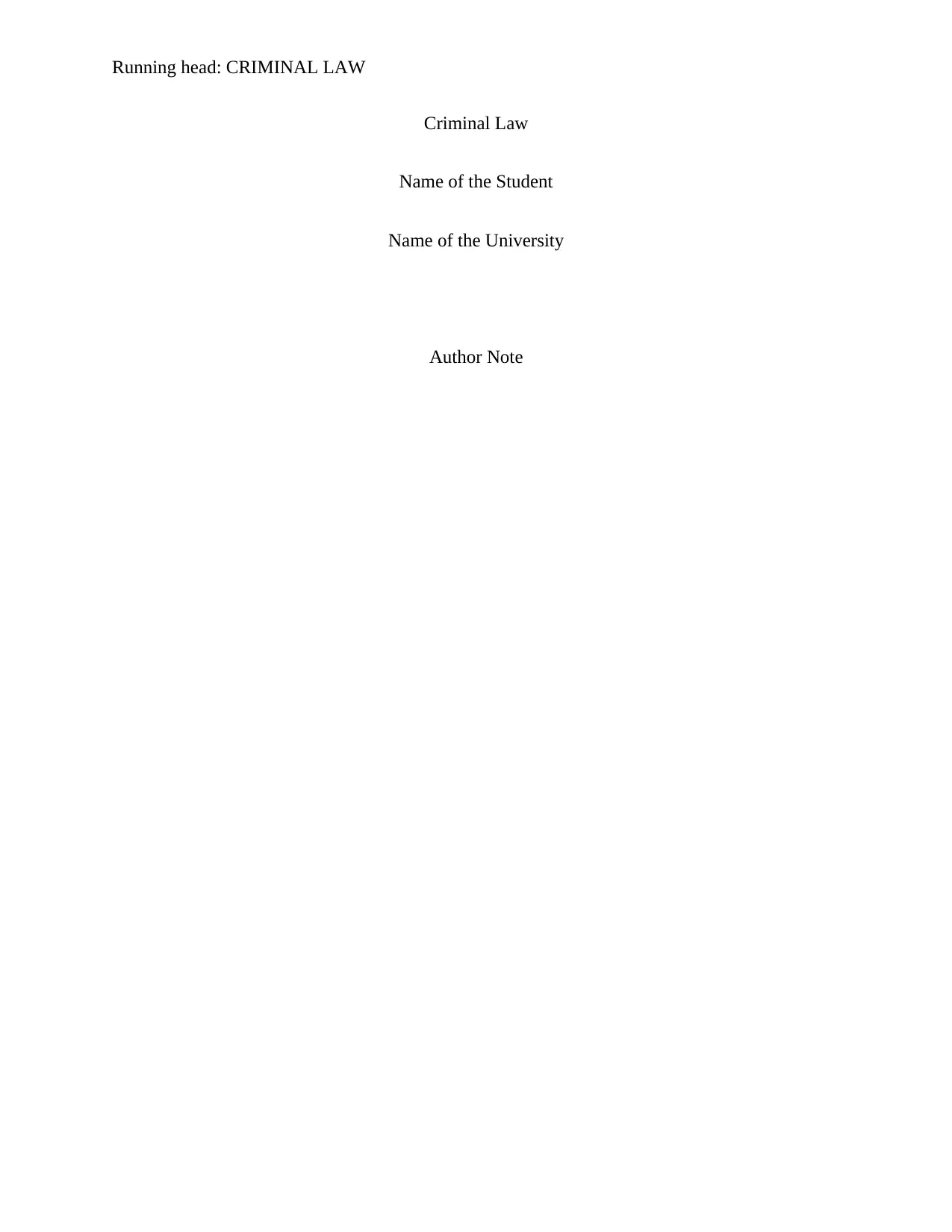
Running head: CRIMINAL LAW
Criminal Law
Name of the Student
Name of the University
Author Note
Criminal Law
Name of the Student
Name of the University
Author Note
Secure Best Marks with AI Grader
Need help grading? Try our AI Grader for instant feedback on your assignments.

1CRIMINAL LAW
The Law Reform Commission in its report on Harmful Communications and Digital
Safety discusses reform in the field of criminal law with respect to harmful digital
communications. The report recommends reforming of harassment offence stipulated under
section 10 of the Non-Fatal Offences against the Person Act 19971. This current legal
framework governs the offences amounting to harassment by any means. However, this
provision does not mention any specific reference with respect to harassment by the online or
digital means that is essential to ensure that this form of harassment is included in the harassment
offence2. The Commission also talks about introducing a particular stalking offence in the
context of digital and online stalking, to be included within the harassment offence. This essay
discusses about the deficiency in the present legal framework that governs harassment law in
Ireland. It also entails the reasons that make it necessary to expand the harassment law by
encompassing a distinct offence of stalking and indirect forms of harassment into the framework
of harassment law dealt under section 10 of the statute.
According to section 10 of the Non-Fatal Offences against the Person Act 1997, any
person who, without any legal authority harasses another person by using any means including
telephone, or continuously watching, following, besetting or by communicating with such person
shall be considered as guilty. This section has been derived from a recommendation made by the
Commission in the 1994 Report on Non-fatal Offences against the Person [LRC 45-1994,
paragraph 9.77]. It was stated that any act of harassment that results in serious interference with
a right of another person to lead a personal and peaceful life should be included in the criminal
law instead of the facts that gives rise to the fear of violence that are otherwise, covered by the
offence of coercion.
1Non-Fatal Offences against the Person Act 1997 (section 10).
2 Geach, Neal, and Nicola Haralambous. "Regulating harassment: is the law fit for the social networking age?." The
Journal of Criminal Law 73.3 (2009): 241-257.
The Law Reform Commission in its report on Harmful Communications and Digital
Safety discusses reform in the field of criminal law with respect to harmful digital
communications. The report recommends reforming of harassment offence stipulated under
section 10 of the Non-Fatal Offences against the Person Act 19971. This current legal
framework governs the offences amounting to harassment by any means. However, this
provision does not mention any specific reference with respect to harassment by the online or
digital means that is essential to ensure that this form of harassment is included in the harassment
offence2. The Commission also talks about introducing a particular stalking offence in the
context of digital and online stalking, to be included within the harassment offence. This essay
discusses about the deficiency in the present legal framework that governs harassment law in
Ireland. It also entails the reasons that make it necessary to expand the harassment law by
encompassing a distinct offence of stalking and indirect forms of harassment into the framework
of harassment law dealt under section 10 of the statute.
According to section 10 of the Non-Fatal Offences against the Person Act 1997, any
person who, without any legal authority harasses another person by using any means including
telephone, or continuously watching, following, besetting or by communicating with such person
shall be considered as guilty. This section has been derived from a recommendation made by the
Commission in the 1994 Report on Non-fatal Offences against the Person [LRC 45-1994,
paragraph 9.77]. It was stated that any act of harassment that results in serious interference with
a right of another person to lead a personal and peaceful life should be included in the criminal
law instead of the facts that gives rise to the fear of violence that are otherwise, covered by the
offence of coercion.
1Non-Fatal Offences against the Person Act 1997 (section 10).
2 Geach, Neal, and Nicola Haralambous. "Regulating harassment: is the law fit for the social networking age?." The
Journal of Criminal Law 73.3 (2009): 241-257.

2CRIMINAL LAW
It is an essential requirement of the statutory provision stipulated under section 10 of the
Act that the words ‘watching, following, pestering, communicating, besetting’ must be
established to be continuous in nature. It is important for these conduct to be persisting in nature
as these conducts under section 10, are otherwise considered lawful acts and it only amounts to
an offence, when such act is continuously repeated to such extent that it is interfering with the
privacy and peace or causes harm or distress to the other person3.
According to Gillespie (2006), the term ‘persistently’ had been construed in a manner
that was independent of any specific number of incidents or any time frame within which such
incidents had occurred. While a single prolonged act may satisfy the requirement for persistence,
separate incidents, which are not delayed, should not amount to criminal liability under section
10 of the Act. In Director of Public Prosecutions (O’Dowd) v Lynch [2008]4, the accused was
convicted under section 10 of the statute for continuously committing sexual exposure in front of
two children, amounting to harassment offence. The Court held that the fundamental requirement
of persistence under section 10 is continuous behavior that may include either several incidents
or a single incident, but continuous incident that has a prolong effect.
The penalties stipulated under section 10(6) of the statute imposes upon the offender
imprisonment and/or fine for a term not exceeding 12 months on summary conviction and
conviction for 7 years on accusation. In addition, the court may issue an order restraining the
defendant from communicating with the harassed person and maintain certain distance from the
residence or employment of such harassed person. In regards to the deficiencies existing in the
present legal framework governing harassment laws, the necessity to expand the statute to
3 Hanly, Conor. An introduction to Irish criminal law. Gill & Macmillan, 2006.
4 [2008] IEHC 183.
It is an essential requirement of the statutory provision stipulated under section 10 of the
Act that the words ‘watching, following, pestering, communicating, besetting’ must be
established to be continuous in nature. It is important for these conduct to be persisting in nature
as these conducts under section 10, are otherwise considered lawful acts and it only amounts to
an offence, when such act is continuously repeated to such extent that it is interfering with the
privacy and peace or causes harm or distress to the other person3.
According to Gillespie (2006), the term ‘persistently’ had been construed in a manner
that was independent of any specific number of incidents or any time frame within which such
incidents had occurred. While a single prolonged act may satisfy the requirement for persistence,
separate incidents, which are not delayed, should not amount to criminal liability under section
10 of the Act. In Director of Public Prosecutions (O’Dowd) v Lynch [2008]4, the accused was
convicted under section 10 of the statute for continuously committing sexual exposure in front of
two children, amounting to harassment offence. The Court held that the fundamental requirement
of persistence under section 10 is continuous behavior that may include either several incidents
or a single incident, but continuous incident that has a prolong effect.
The penalties stipulated under section 10(6) of the statute imposes upon the offender
imprisonment and/or fine for a term not exceeding 12 months on summary conviction and
conviction for 7 years on accusation. In addition, the court may issue an order restraining the
defendant from communicating with the harassed person and maintain certain distance from the
residence or employment of such harassed person. In regards to the deficiencies existing in the
present legal framework governing harassment laws, the necessity to expand the statute to
3 Hanly, Conor. An introduction to Irish criminal law. Gill & Macmillan, 2006.
4 [2008] IEHC 183.
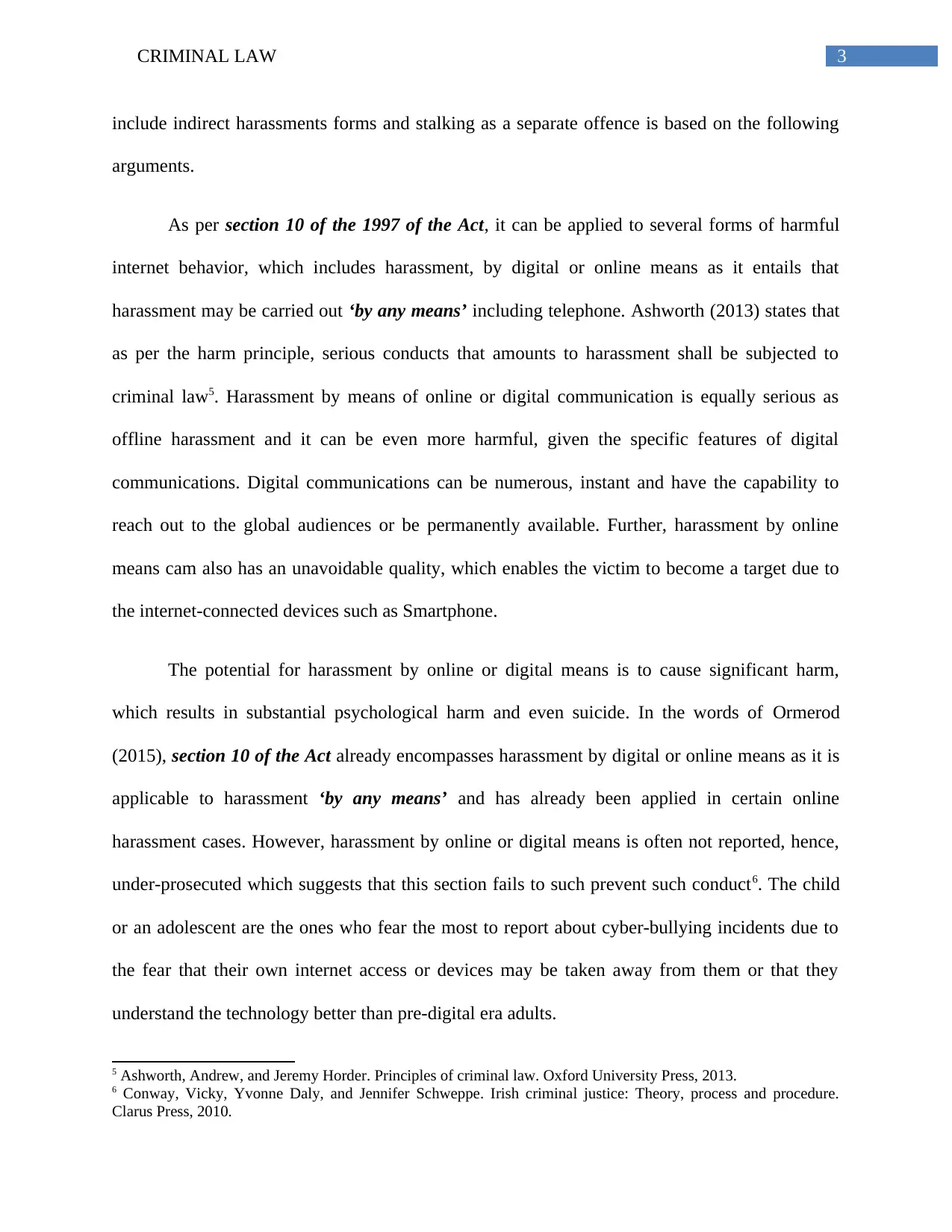
3CRIMINAL LAW
include indirect harassments forms and stalking as a separate offence is based on the following
arguments.
As per section 10 of the 1997 of the Act, it can be applied to several forms of harmful
internet behavior, which includes harassment, by digital or online means as it entails that
harassment may be carried out ‘by any means’ including telephone. Ashworth (2013) states that
as per the harm principle, serious conducts that amounts to harassment shall be subjected to
criminal law5. Harassment by means of online or digital communication is equally serious as
offline harassment and it can be even more harmful, given the specific features of digital
communications. Digital communications can be numerous, instant and have the capability to
reach out to the global audiences or be permanently available. Further, harassment by online
means cam also has an unavoidable quality, which enables the victim to become a target due to
the internet-connected devices such as Smartphone.
The potential for harassment by online or digital means is to cause significant harm,
which results in substantial psychological harm and even suicide. In the words of Ormerod
(2015), section 10 of the Act already encompasses harassment by digital or online means as it is
applicable to harassment ‘by any means’ and has already been applied in certain online
harassment cases. However, harassment by online or digital means is often not reported, hence,
under-prosecuted which suggests that this section fails to such prevent such conduct6. The child
or an adolescent are the ones who fear the most to report about cyber-bullying incidents due to
the fear that their own internet access or devices may be taken away from them or that they
understand the technology better than pre-digital era adults.
5 Ashworth, Andrew, and Jeremy Horder. Principles of criminal law. Oxford University Press, 2013.
6 Conway, Vicky, Yvonne Daly, and Jennifer Schweppe. Irish criminal justice: Theory, process and procedure.
Clarus Press, 2010.
include indirect harassments forms and stalking as a separate offence is based on the following
arguments.
As per section 10 of the 1997 of the Act, it can be applied to several forms of harmful
internet behavior, which includes harassment, by digital or online means as it entails that
harassment may be carried out ‘by any means’ including telephone. Ashworth (2013) states that
as per the harm principle, serious conducts that amounts to harassment shall be subjected to
criminal law5. Harassment by means of online or digital communication is equally serious as
offline harassment and it can be even more harmful, given the specific features of digital
communications. Digital communications can be numerous, instant and have the capability to
reach out to the global audiences or be permanently available. Further, harassment by online
means cam also has an unavoidable quality, which enables the victim to become a target due to
the internet-connected devices such as Smartphone.
The potential for harassment by online or digital means is to cause significant harm,
which results in substantial psychological harm and even suicide. In the words of Ormerod
(2015), section 10 of the Act already encompasses harassment by digital or online means as it is
applicable to harassment ‘by any means’ and has already been applied in certain online
harassment cases. However, harassment by online or digital means is often not reported, hence,
under-prosecuted which suggests that this section fails to such prevent such conduct6. The child
or an adolescent are the ones who fear the most to report about cyber-bullying incidents due to
the fear that their own internet access or devices may be taken away from them or that they
understand the technology better than pre-digital era adults.
5 Ashworth, Andrew, and Jeremy Horder. Principles of criminal law. Oxford University Press, 2013.
6 Conway, Vicky, Yvonne Daly, and Jennifer Schweppe. Irish criminal justice: Theory, process and procedure.
Clarus Press, 2010.
Secure Best Marks with AI Grader
Need help grading? Try our AI Grader for instant feedback on your assignments.
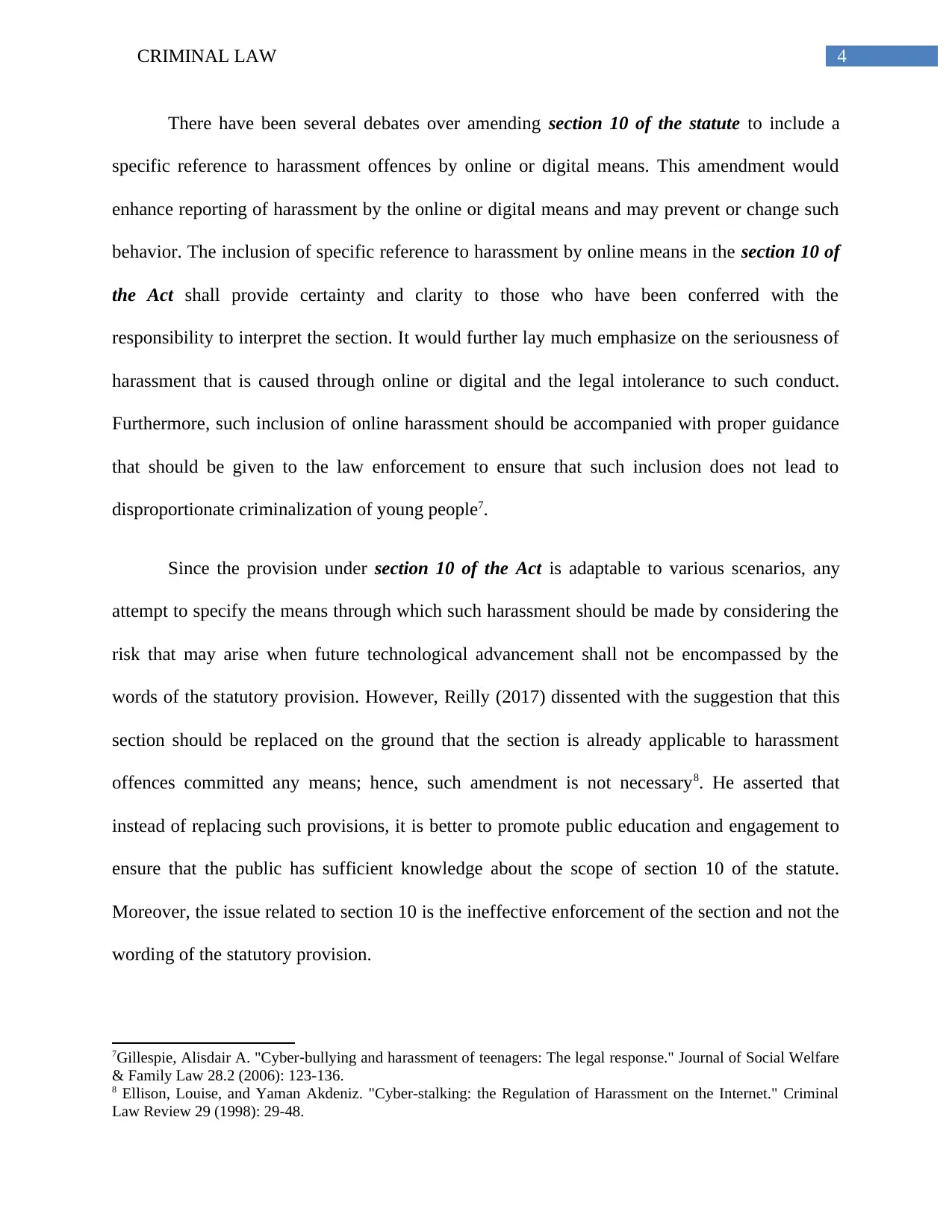
4CRIMINAL LAW
There have been several debates over amending section 10 of the statute to include a
specific reference to harassment offences by online or digital means. This amendment would
enhance reporting of harassment by the online or digital means and may prevent or change such
behavior. The inclusion of specific reference to harassment by online means in the section 10 of
the Act shall provide certainty and clarity to those who have been conferred with the
responsibility to interpret the section. It would further lay much emphasize on the seriousness of
harassment that is caused through online or digital and the legal intolerance to such conduct.
Furthermore, such inclusion of online harassment should be accompanied with proper guidance
that should be given to the law enforcement to ensure that such inclusion does not lead to
disproportionate criminalization of young people7.
Since the provision under section 10 of the Act is adaptable to various scenarios, any
attempt to specify the means through which such harassment should be made by considering the
risk that may arise when future technological advancement shall not be encompassed by the
words of the statutory provision. However, Reilly (2017) dissented with the suggestion that this
section should be replaced on the ground that the section is already applicable to harassment
offences committed any means; hence, such amendment is not necessary8. He asserted that
instead of replacing such provisions, it is better to promote public education and engagement to
ensure that the public has sufficient knowledge about the scope of section 10 of the statute.
Moreover, the issue related to section 10 is the ineffective enforcement of the section and not the
wording of the statutory provision.
7Gillespie, Alisdair A. "Cyber‐bullying and harassment of teenagers: The legal response." Journal of Social Welfare
& Family Law 28.2 (2006): 123-136.
8 Ellison, Louise, and Yaman Akdeniz. "Cyber-stalking: the Regulation of Harassment on the Internet." Criminal
Law Review 29 (1998): 29-48.
There have been several debates over amending section 10 of the statute to include a
specific reference to harassment offences by online or digital means. This amendment would
enhance reporting of harassment by the online or digital means and may prevent or change such
behavior. The inclusion of specific reference to harassment by online means in the section 10 of
the Act shall provide certainty and clarity to those who have been conferred with the
responsibility to interpret the section. It would further lay much emphasize on the seriousness of
harassment that is caused through online or digital and the legal intolerance to such conduct.
Furthermore, such inclusion of online harassment should be accompanied with proper guidance
that should be given to the law enforcement to ensure that such inclusion does not lead to
disproportionate criminalization of young people7.
Since the provision under section 10 of the Act is adaptable to various scenarios, any
attempt to specify the means through which such harassment should be made by considering the
risk that may arise when future technological advancement shall not be encompassed by the
words of the statutory provision. However, Reilly (2017) dissented with the suggestion that this
section should be replaced on the ground that the section is already applicable to harassment
offences committed any means; hence, such amendment is not necessary8. He asserted that
instead of replacing such provisions, it is better to promote public education and engagement to
ensure that the public has sufficient knowledge about the scope of section 10 of the statute.
Moreover, the issue related to section 10 is the ineffective enforcement of the section and not the
wording of the statutory provision.
7Gillespie, Alisdair A. "Cyber‐bullying and harassment of teenagers: The legal response." Journal of Social Welfare
& Family Law 28.2 (2006): 123-136.
8 Ellison, Louise, and Yaman Akdeniz. "Cyber-stalking: the Regulation of Harassment on the Internet." Criminal
Law Review 29 (1998): 29-48.
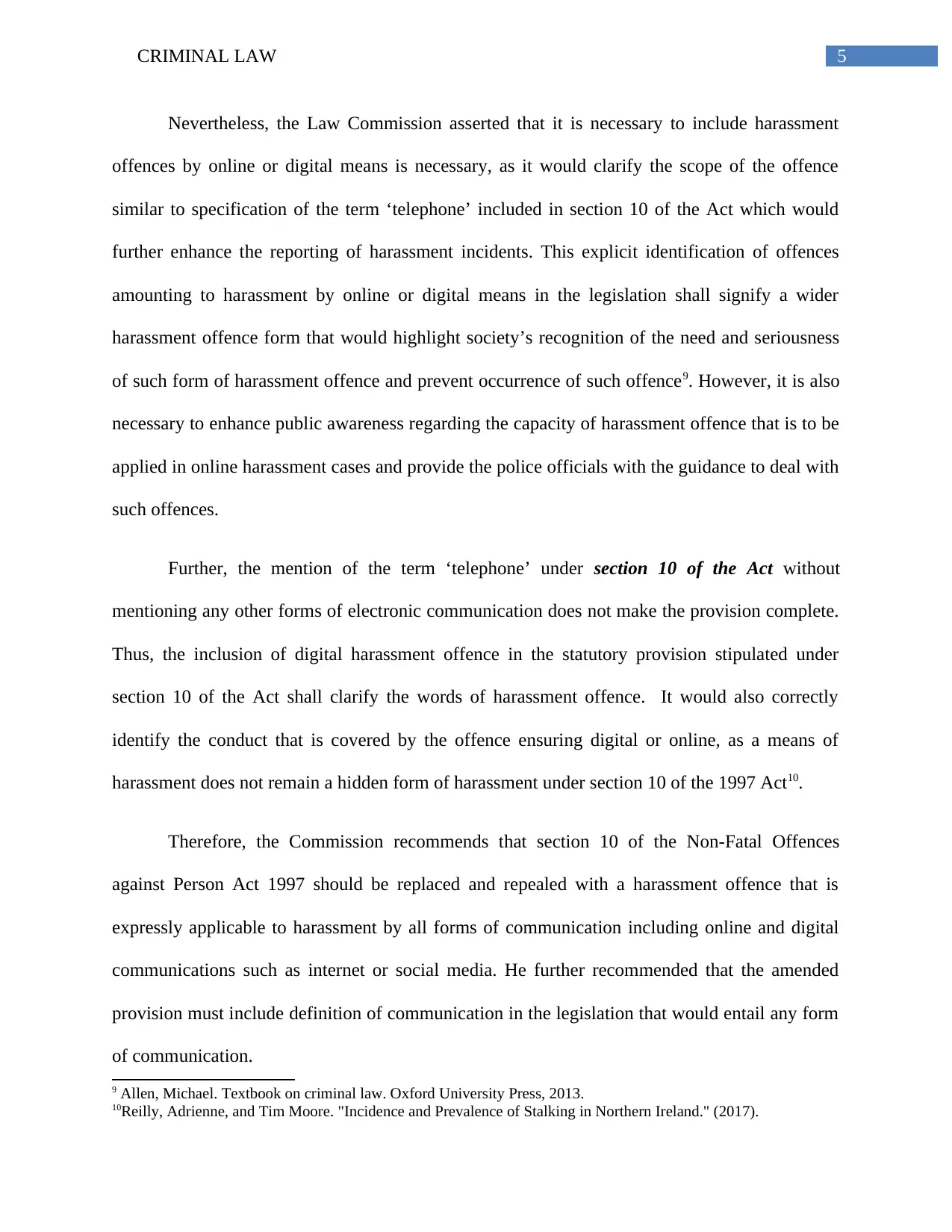
5CRIMINAL LAW
Nevertheless, the Law Commission asserted that it is necessary to include harassment
offences by online or digital means is necessary, as it would clarify the scope of the offence
similar to specification of the term ‘telephone’ included in section 10 of the Act which would
further enhance the reporting of harassment incidents. This explicit identification of offences
amounting to harassment by online or digital means in the legislation shall signify a wider
harassment offence form that would highlight society’s recognition of the need and seriousness
of such form of harassment offence and prevent occurrence of such offence9. However, it is also
necessary to enhance public awareness regarding the capacity of harassment offence that is to be
applied in online harassment cases and provide the police officials with the guidance to deal with
such offences.
Further, the mention of the term ‘telephone’ under section 10 of the Act without
mentioning any other forms of electronic communication does not make the provision complete.
Thus, the inclusion of digital harassment offence in the statutory provision stipulated under
section 10 of the Act shall clarify the words of harassment offence. It would also correctly
identify the conduct that is covered by the offence ensuring digital or online, as a means of
harassment does not remain a hidden form of harassment under section 10 of the 1997 Act10.
Therefore, the Commission recommends that section 10 of the Non-Fatal Offences
against Person Act 1997 should be replaced and repealed with a harassment offence that is
expressly applicable to harassment by all forms of communication including online and digital
communications such as internet or social media. He further recommended that the amended
provision must include definition of communication in the legislation that would entail any form
of communication.
9 Allen, Michael. Textbook on criminal law. Oxford University Press, 2013.
10Reilly, Adrienne, and Tim Moore. "Incidence and Prevalence of Stalking in Northern Ireland." (2017).
Nevertheless, the Law Commission asserted that it is necessary to include harassment
offences by online or digital means is necessary, as it would clarify the scope of the offence
similar to specification of the term ‘telephone’ included in section 10 of the Act which would
further enhance the reporting of harassment incidents. This explicit identification of offences
amounting to harassment by online or digital means in the legislation shall signify a wider
harassment offence form that would highlight society’s recognition of the need and seriousness
of such form of harassment offence and prevent occurrence of such offence9. However, it is also
necessary to enhance public awareness regarding the capacity of harassment offence that is to be
applied in online harassment cases and provide the police officials with the guidance to deal with
such offences.
Further, the mention of the term ‘telephone’ under section 10 of the Act without
mentioning any other forms of electronic communication does not make the provision complete.
Thus, the inclusion of digital harassment offence in the statutory provision stipulated under
section 10 of the Act shall clarify the words of harassment offence. It would also correctly
identify the conduct that is covered by the offence ensuring digital or online, as a means of
harassment does not remain a hidden form of harassment under section 10 of the 1997 Act10.
Therefore, the Commission recommends that section 10 of the Non-Fatal Offences
against Person Act 1997 should be replaced and repealed with a harassment offence that is
expressly applicable to harassment by all forms of communication including online and digital
communications such as internet or social media. He further recommended that the amended
provision must include definition of communication in the legislation that would entail any form
of communication.
9 Allen, Michael. Textbook on criminal law. Oxford University Press, 2013.
10Reilly, Adrienne, and Tim Moore. "Incidence and Prevalence of Stalking in Northern Ireland." (2017).

6CRIMINAL LAW
In regards to indirect forms of harassments, it is recommended that it should also be
considered equally serious offence. Indirect forms of harassments include continuous harmful
communications made through social media sites, email or other online and digital means
regarding a particular person to third parties, but such communication takes place indirectly.
There is a gap in the Irish law with respect to indirect harassment as the Act of 1997 specifically
with direct communications with the concerned persons and it deals less with communications
about someone, hence, it does not have a broad interpretation. According to Ormerod (2015), this
deficiency can be met by amending the harassment offense to include harassing communication
with ‘any person’ instead of any target of such harassing behavior. In the online context, it
would clarify that it is a criminal offense to post any harassing communications on a public
medium or to send digital communications to any third party, which might result harmful to the
victim as was held in R v Debnath [2005]11.
According to section 10 of the Irish Act of 1997, the accused must be engaged in
watching, besetting, communicating and pestering with the victim to establish the fact that the
accused is guilty of committing direct harassment offense. The requirement to communicate with
the victims would imply that it is unlikely that section 10 could be interpreted while dealing with
cases involving indirect activities12. Hence, under indirect form of communication, the offending
communication is sent to third parties instead of the offender, it may not amount to
communication to victim. The language used in the section shall exclude indirect type of
behavior and harmful messages posted on a private social media page are not covered by section
10 of the Act. Indirect harassment is included in the English Protection from Harassment Act
1997 as it defines harassment in more general terms compared to section 10 of the Act. This is
11 [2005] EWCA Crim 3472.
12 Reilly, Adrienne. "Legislative Position on Stalking and Relevant Statistics in the UK and the Republic of Ireland."
(2017).
In regards to indirect forms of harassments, it is recommended that it should also be
considered equally serious offence. Indirect forms of harassments include continuous harmful
communications made through social media sites, email or other online and digital means
regarding a particular person to third parties, but such communication takes place indirectly.
There is a gap in the Irish law with respect to indirect harassment as the Act of 1997 specifically
with direct communications with the concerned persons and it deals less with communications
about someone, hence, it does not have a broad interpretation. According to Ormerod (2015), this
deficiency can be met by amending the harassment offense to include harassing communication
with ‘any person’ instead of any target of such harassing behavior. In the online context, it
would clarify that it is a criminal offense to post any harassing communications on a public
medium or to send digital communications to any third party, which might result harmful to the
victim as was held in R v Debnath [2005]11.
According to section 10 of the Irish Act of 1997, the accused must be engaged in
watching, besetting, communicating and pestering with the victim to establish the fact that the
accused is guilty of committing direct harassment offense. The requirement to communicate with
the victims would imply that it is unlikely that section 10 could be interpreted while dealing with
cases involving indirect activities12. Hence, under indirect form of communication, the offending
communication is sent to third parties instead of the offender, it may not amount to
communication to victim. The language used in the section shall exclude indirect type of
behavior and harmful messages posted on a private social media page are not covered by section
10 of the Act. Indirect harassment is included in the English Protection from Harassment Act
1997 as it defines harassment in more general terms compared to section 10 of the Act. This is
11 [2005] EWCA Crim 3472.
12 Reilly, Adrienne. "Legislative Position on Stalking and Relevant Statistics in the UK and the Republic of Ireland."
(2017).
Paraphrase This Document
Need a fresh take? Get an instant paraphrase of this document with our AI Paraphraser
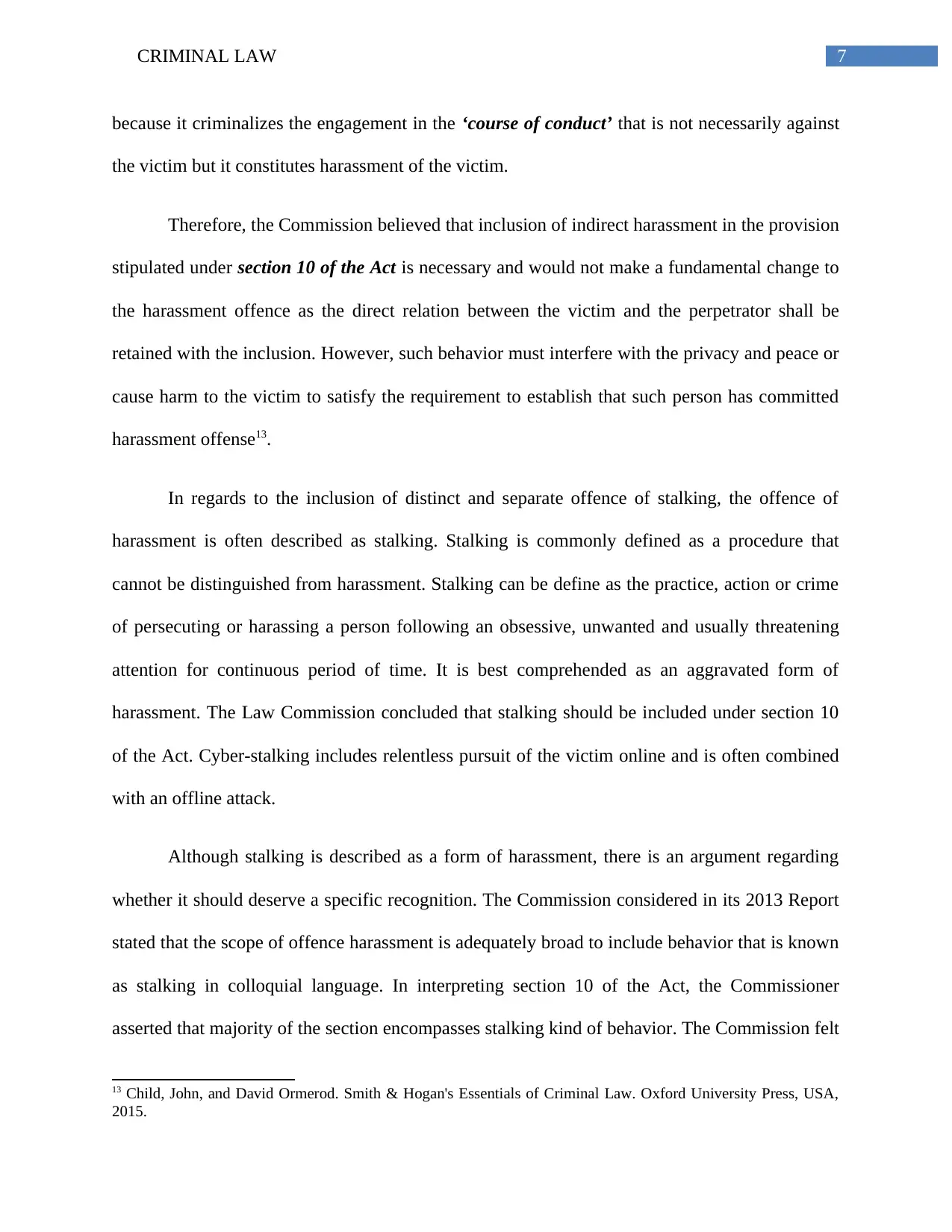
7CRIMINAL LAW
because it criminalizes the engagement in the ‘course of conduct’ that is not necessarily against
the victim but it constitutes harassment of the victim.
Therefore, the Commission believed that inclusion of indirect harassment in the provision
stipulated under section 10 of the Act is necessary and would not make a fundamental change to
the harassment offence as the direct relation between the victim and the perpetrator shall be
retained with the inclusion. However, such behavior must interfere with the privacy and peace or
cause harm to the victim to satisfy the requirement to establish that such person has committed
harassment offense13.
In regards to the inclusion of distinct and separate offence of stalking, the offence of
harassment is often described as stalking. Stalking is commonly defined as a procedure that
cannot be distinguished from harassment. Stalking can be define as the practice, action or crime
of persecuting or harassing a person following an obsessive, unwanted and usually threatening
attention for continuous period of time. It is best comprehended as an aggravated form of
harassment. The Law Commission concluded that stalking should be included under section 10
of the Act. Cyber-stalking includes relentless pursuit of the victim online and is often combined
with an offline attack.
Although stalking is described as a form of harassment, there is an argument regarding
whether it should deserve a specific recognition. The Commission considered in its 2013 Report
stated that the scope of offence harassment is adequately broad to include behavior that is known
as stalking in colloquial language. In interpreting section 10 of the Act, the Commissioner
asserted that majority of the section encompasses stalking kind of behavior. The Commission felt
13 Child, John, and David Ormerod. Smith & Hogan's Essentials of Criminal Law. Oxford University Press, USA,
2015.
because it criminalizes the engagement in the ‘course of conduct’ that is not necessarily against
the victim but it constitutes harassment of the victim.
Therefore, the Commission believed that inclusion of indirect harassment in the provision
stipulated under section 10 of the Act is necessary and would not make a fundamental change to
the harassment offence as the direct relation between the victim and the perpetrator shall be
retained with the inclusion. However, such behavior must interfere with the privacy and peace or
cause harm to the victim to satisfy the requirement to establish that such person has committed
harassment offense13.
In regards to the inclusion of distinct and separate offence of stalking, the offence of
harassment is often described as stalking. Stalking is commonly defined as a procedure that
cannot be distinguished from harassment. Stalking can be define as the practice, action or crime
of persecuting or harassing a person following an obsessive, unwanted and usually threatening
attention for continuous period of time. It is best comprehended as an aggravated form of
harassment. The Law Commission concluded that stalking should be included under section 10
of the Act. Cyber-stalking includes relentless pursuit of the victim online and is often combined
with an offline attack.
Although stalking is described as a form of harassment, there is an argument regarding
whether it should deserve a specific recognition. The Commission considered in its 2013 Report
stated that the scope of offence harassment is adequately broad to include behavior that is known
as stalking in colloquial language. In interpreting section 10 of the Act, the Commissioner
asserted that majority of the section encompasses stalking kind of behavior. The Commission felt
13 Child, John, and David Ormerod. Smith & Hogan's Essentials of Criminal Law. Oxford University Press, USA,
2015.

8CRIMINAL LAW
that introducing a specific form of stalking offence shall unnecessarily complicate the
interpretation of the statutory provision and result in duplication of criminal law. However, the
Commission decided to deal with the issue relating to whether stalking through online or digital
means be incorporated as a specific and distinct offence14.
In Northern Ireland, legal cases related to stalking are prosecuted under the harassment
offences in section 4 and 6 of the Protection from Harassment (Northern Ireland Order 1997).
However, in Ireland, the introduction of stalking as a specific offence has been suggested given
the experiences of England and Wales and Scotland. According to Hanly (2013), identifying
stalking as a specific and distinct offence in Ireland would be advantageous and significance for
victims of stalking owing to the ‘hidden’ nature of crime as well as the serious nature of such
crime in comparison to the offense of harassment. The incorporation of stalking in legislation
instead of its inclusion within the wide-ranging offence of harassment would enable to underline
the various and more menacing character of such crime.
This led the Commission realize that stalking as a distinct offence should be introduced
as a separate offence from the harassment offence. However, the Commission considered the
amended elements of harassment offense as essential ingredients of a stalking offence, that is, a
stalking offence shall be committed where a person stalks another person continuously by
communicating through online or digitally or by communicating information about one person to
another person. Further, the person must have interfered with the peace and privacy of another
person persistently, intentionally and have caused distress or alarm to such person, which any
prudent person would comprehend as an interference with privacy and peace of another person15.
14Child, John, and David Ormerod. Smith & Hogan's Essentials of Criminal Law. Oxford University Press, USA,
2015.
15 Ormerod, David, et al. Smith and Hogan's criminal law. Oxford University Press, USA, 2015.
that introducing a specific form of stalking offence shall unnecessarily complicate the
interpretation of the statutory provision and result in duplication of criminal law. However, the
Commission decided to deal with the issue relating to whether stalking through online or digital
means be incorporated as a specific and distinct offence14.
In Northern Ireland, legal cases related to stalking are prosecuted under the harassment
offences in section 4 and 6 of the Protection from Harassment (Northern Ireland Order 1997).
However, in Ireland, the introduction of stalking as a specific offence has been suggested given
the experiences of England and Wales and Scotland. According to Hanly (2013), identifying
stalking as a specific and distinct offence in Ireland would be advantageous and significance for
victims of stalking owing to the ‘hidden’ nature of crime as well as the serious nature of such
crime in comparison to the offense of harassment. The incorporation of stalking in legislation
instead of its inclusion within the wide-ranging offence of harassment would enable to underline
the various and more menacing character of such crime.
This led the Commission realize that stalking as a distinct offence should be introduced
as a separate offence from the harassment offence. However, the Commission considered the
amended elements of harassment offense as essential ingredients of a stalking offence, that is, a
stalking offence shall be committed where a person stalks another person continuously by
communicating through online or digitally or by communicating information about one person to
another person. Further, the person must have interfered with the peace and privacy of another
person persistently, intentionally and have caused distress or alarm to such person, which any
prudent person would comprehend as an interference with privacy and peace of another person15.
14Child, John, and David Ormerod. Smith & Hogan's Essentials of Criminal Law. Oxford University Press, USA,
2015.
15 Ormerod, David, et al. Smith and Hogan's criminal law. Oxford University Press, USA, 2015.

9CRIMINAL LAW
Therefore, the only distinction between an offence of harassment and the offence of
stalking is that in case of the latter, the accused must act recklessly or intentionally or have
caused any form of distress to the concerned person, thus interfering with the privacy or peace of
the victim. This additional requirement should be fulfilled to meet the stalking offence and to
distinguish it from the offence of harassment. The offence of stalking shall include same penalty
as the offence of harassment16.
From the above discussion, it can be inferred that digital communication and internet
advancements and other dangerous ways which may hinder individual privacy. The digital or
online world exposes the vulnerable individuals to severe privacy violations by way of posting
false, shameful, private, shameful or harmful content with the help of social media sites. The
harm that is caused to the person against whom such content is posted online as such information
spread instantly and reaches out to global audiences. Such interferences with the private life of
an individual might have a significant impact upon the psychological and mental health of such
individual. Therefore, it is essential that the issues of the victims should be addressed effectively
and the government should ensure that the privacy of individuals is appropriately safeguarded.
16 Reilly, Adrienne, and Tim Moore. "Incidence and Prevalence of Stalking in Northern Ireland." (2017).
Therefore, the only distinction between an offence of harassment and the offence of
stalking is that in case of the latter, the accused must act recklessly or intentionally or have
caused any form of distress to the concerned person, thus interfering with the privacy or peace of
the victim. This additional requirement should be fulfilled to meet the stalking offence and to
distinguish it from the offence of harassment. The offence of stalking shall include same penalty
as the offence of harassment16.
From the above discussion, it can be inferred that digital communication and internet
advancements and other dangerous ways which may hinder individual privacy. The digital or
online world exposes the vulnerable individuals to severe privacy violations by way of posting
false, shameful, private, shameful or harmful content with the help of social media sites. The
harm that is caused to the person against whom such content is posted online as such information
spread instantly and reaches out to global audiences. Such interferences with the private life of
an individual might have a significant impact upon the psychological and mental health of such
individual. Therefore, it is essential that the issues of the victims should be addressed effectively
and the government should ensure that the privacy of individuals is appropriately safeguarded.
16 Reilly, Adrienne, and Tim Moore. "Incidence and Prevalence of Stalking in Northern Ireland." (2017).
Secure Best Marks with AI Grader
Need help grading? Try our AI Grader for instant feedback on your assignments.
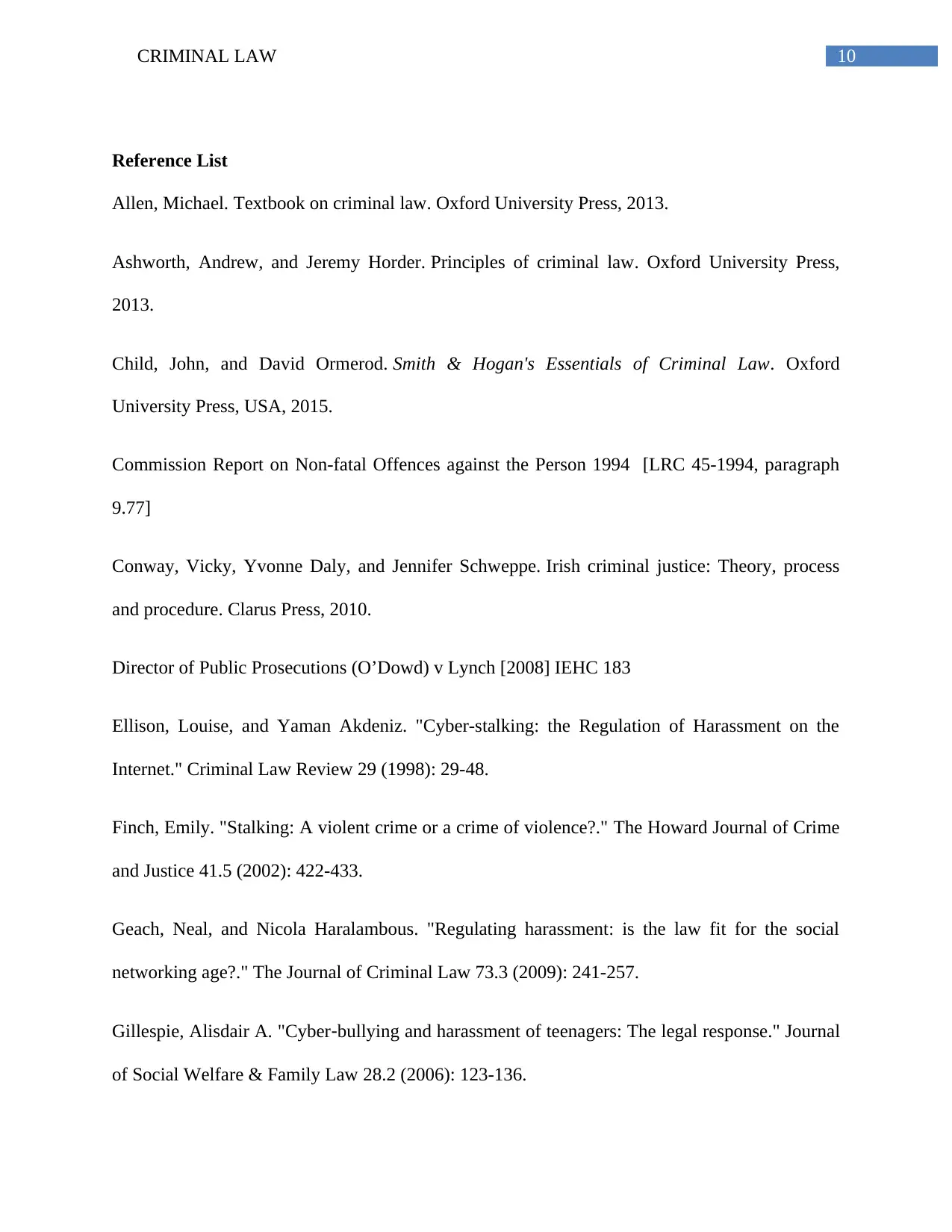
10CRIMINAL LAW
Reference List
Allen, Michael. Textbook on criminal law. Oxford University Press, 2013.
Ashworth, Andrew, and Jeremy Horder. Principles of criminal law. Oxford University Press,
2013.
Child, John, and David Ormerod. Smith & Hogan's Essentials of Criminal Law. Oxford
University Press, USA, 2015.
Commission Report on Non-fatal Offences against the Person 1994 [LRC 45-1994, paragraph
9.77]
Conway, Vicky, Yvonne Daly, and Jennifer Schweppe. Irish criminal justice: Theory, process
and procedure. Clarus Press, 2010.
Director of Public Prosecutions (O’Dowd) v Lynch [2008] IEHC 183
Ellison, Louise, and Yaman Akdeniz. "Cyber-stalking: the Regulation of Harassment on the
Internet." Criminal Law Review 29 (1998): 29-48.
Finch, Emily. "Stalking: A violent crime or a crime of violence?." The Howard Journal of Crime
and Justice 41.5 (2002): 422-433.
Geach, Neal, and Nicola Haralambous. "Regulating harassment: is the law fit for the social
networking age?." The Journal of Criminal Law 73.3 (2009): 241-257.
Gillespie, Alisdair A. "Cyber‐bullying and harassment of teenagers: The legal response." Journal
of Social Welfare & Family Law 28.2 (2006): 123-136.
Reference List
Allen, Michael. Textbook on criminal law. Oxford University Press, 2013.
Ashworth, Andrew, and Jeremy Horder. Principles of criminal law. Oxford University Press,
2013.
Child, John, and David Ormerod. Smith & Hogan's Essentials of Criminal Law. Oxford
University Press, USA, 2015.
Commission Report on Non-fatal Offences against the Person 1994 [LRC 45-1994, paragraph
9.77]
Conway, Vicky, Yvonne Daly, and Jennifer Schweppe. Irish criminal justice: Theory, process
and procedure. Clarus Press, 2010.
Director of Public Prosecutions (O’Dowd) v Lynch [2008] IEHC 183
Ellison, Louise, and Yaman Akdeniz. "Cyber-stalking: the Regulation of Harassment on the
Internet." Criminal Law Review 29 (1998): 29-48.
Finch, Emily. "Stalking: A violent crime or a crime of violence?." The Howard Journal of Crime
and Justice 41.5 (2002): 422-433.
Geach, Neal, and Nicola Haralambous. "Regulating harassment: is the law fit for the social
networking age?." The Journal of Criminal Law 73.3 (2009): 241-257.
Gillespie, Alisdair A. "Cyber‐bullying and harassment of teenagers: The legal response." Journal
of Social Welfare & Family Law 28.2 (2006): 123-136.
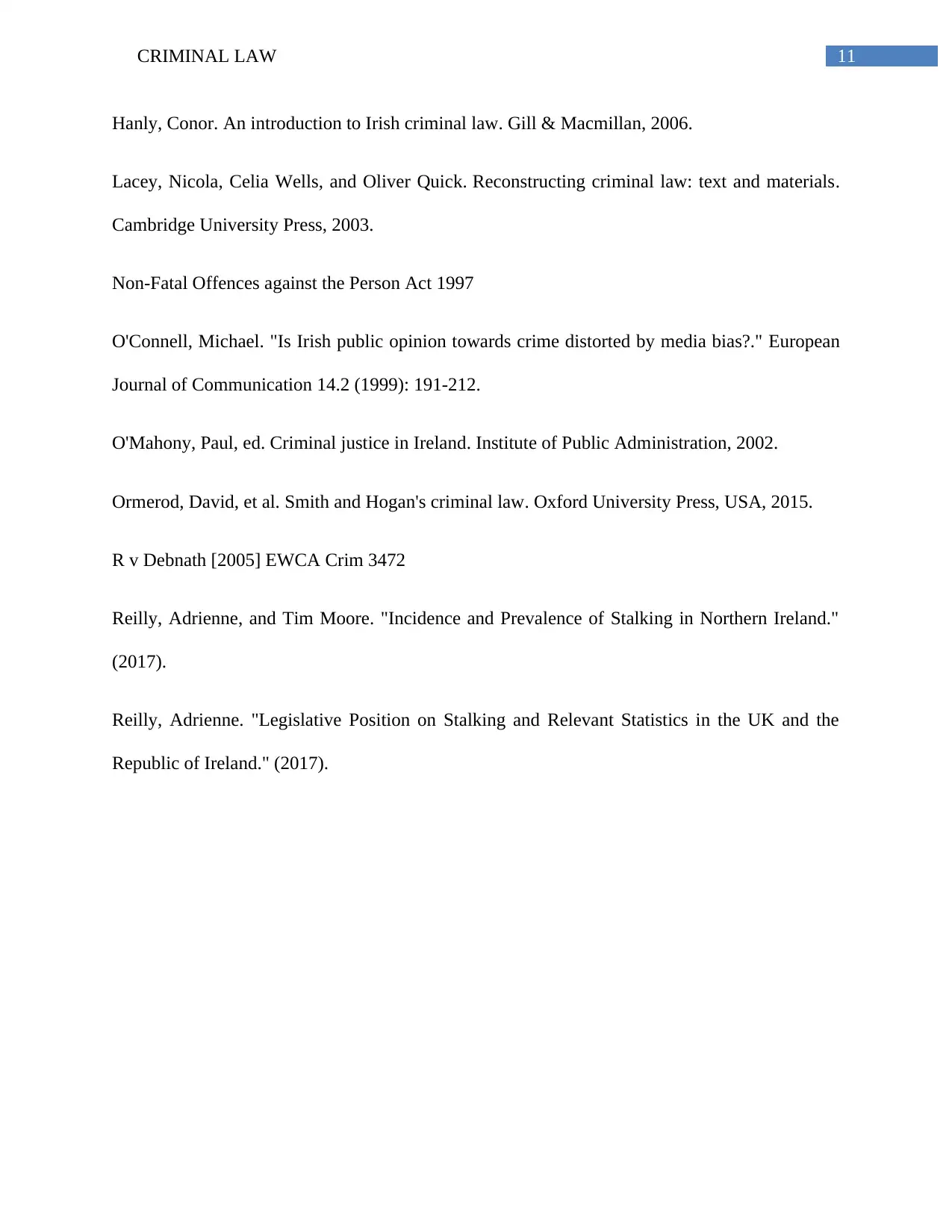
11CRIMINAL LAW
Hanly, Conor. An introduction to Irish criminal law. Gill & Macmillan, 2006.
Lacey, Nicola, Celia Wells, and Oliver Quick. Reconstructing criminal law: text and materials.
Cambridge University Press, 2003.
Non-Fatal Offences against the Person Act 1997
O'Connell, Michael. "Is Irish public opinion towards crime distorted by media bias?." European
Journal of Communication 14.2 (1999): 191-212.
O'Mahony, Paul, ed. Criminal justice in Ireland. Institute of Public Administration, 2002.
Ormerod, David, et al. Smith and Hogan's criminal law. Oxford University Press, USA, 2015.
R v Debnath [2005] EWCA Crim 3472
Reilly, Adrienne, and Tim Moore. "Incidence and Prevalence of Stalking in Northern Ireland."
(2017).
Reilly, Adrienne. "Legislative Position on Stalking and Relevant Statistics in the UK and the
Republic of Ireland." (2017).
Hanly, Conor. An introduction to Irish criminal law. Gill & Macmillan, 2006.
Lacey, Nicola, Celia Wells, and Oliver Quick. Reconstructing criminal law: text and materials.
Cambridge University Press, 2003.
Non-Fatal Offences against the Person Act 1997
O'Connell, Michael. "Is Irish public opinion towards crime distorted by media bias?." European
Journal of Communication 14.2 (1999): 191-212.
O'Mahony, Paul, ed. Criminal justice in Ireland. Institute of Public Administration, 2002.
Ormerod, David, et al. Smith and Hogan's criminal law. Oxford University Press, USA, 2015.
R v Debnath [2005] EWCA Crim 3472
Reilly, Adrienne, and Tim Moore. "Incidence and Prevalence of Stalking in Northern Ireland."
(2017).
Reilly, Adrienne. "Legislative Position on Stalking and Relevant Statistics in the UK and the
Republic of Ireland." (2017).

12CRIMINAL LAW
1 out of 13
Related Documents
Your All-in-One AI-Powered Toolkit for Academic Success.
+13062052269
info@desklib.com
Available 24*7 on WhatsApp / Email
![[object Object]](/_next/static/media/star-bottom.7253800d.svg)
Unlock your academic potential
© 2024 | Zucol Services PVT LTD | All rights reserved.





